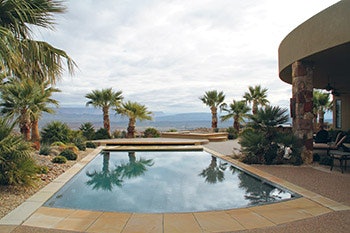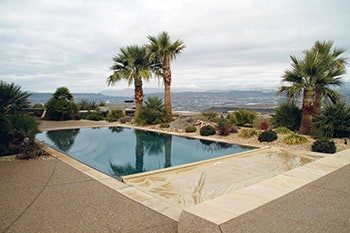
As custom swimming pool designs become increasingly daring, suppliers of automatic covers are being asked to adapt their products to a variety of construction details. The project pictured here offered just such a challenge for Coverstar (part of the Latham family), which was asked to make an automatic cover function with a perimeter-overflow edge treatment without visual disruption.
It’s a welcome challenge, making our covers work in highly customized pool settings. Case in point: this pool located in St. George, Utah, was the first we’ve done where the track system is fully concealed in a deck-level perimeter overflow slot.
Constructed by Jeff Norton of Sunset Pools, the project is located in an area that features sweeping vistas and scores of custom homes. The pool and outside area were built at the same time as the house, which was featured in the 2011 St. George Parade of Homes. The clients made a significant investment in the contemporary aesthetics of the home and while they wanted the benefits of an automatic cover, they had no desire to visually compromise the project with noticeable tracks on the coping.
The pool is 33 by 16 feet with a beautifully modified rectilinear design, gorgeous stone coping and a lavish all-tile interior surface. The entire outdoor area, which also includes a spa and outdoor kitchen area, is carefully designed to blend with the home’s elegant, contemporary architecture and rich material palette.
Overall, the project stands as a wonderful example of how homeowners are becoming more sophisticated in their desires for integration with indoor and outdoor spaces — and how designers and builders are stepping up to meet those expectations.
IN THE SLOT

This type of edge treatment is intended to present a seamless transition between the water’s surface and the surrounding deck area. It’s a fantastic detail, but in the past, there was no place to conceal a track on a perimeter overflow pool. Until this project came along, the tracks wound up just sitting on top of the deck — a necessary compromise in appearance made in favor of obtaining the benefits of an automatic cover.
Although perimeter overflows have increased in popularity, when we became involved with this project last year, we still hadn’t seen all that many. The ones we had worked with, we weren’t terribly surprised that some people wondered if there was a solution where the tracks would be concealed. That’s certainly understandable in that the whole idea behind a deck-level perimeter overflow of this kind is to create an almost magical-looking visual progression from the water’s mirror surface to the surrounding space.
So we pressed ourselves to develop an alternate approach. And for the first time, we figured out a way to hide the track inside the slot that also serves as the weir for the edge.
The track is located beneath the stone material on the outer edge of the slot, hung underneath the coping in the same area where the overflow trough is located. The difficult thing about this is that you only have a one-inch groove down each side of the pool, and this groove has to serve the dual purpose of accessing the track and accommodating the flow over the edge.
TUCKED IN
The solution: We fabricated leading-edge support brackets that would come out of the trough and keep the lead bar above the water.
For the most part it’s a fairly straightforward and simple solution, but being the first we were nonetheless concerned it would work. Much to the delight of everyone involved, the cover functioned beautifully from the start and only required some minor adjustment.
Because we were involved early on in the project, the builder was also able to adapt the treatment of the vault, as well. Rather than setting the vault on the deck, they designed the area with a raised portion of the deck that completely conceals the vault and the lead edge of the cover when the pool is open.
As a result, there’s a beautiful vertical transition in the deck that interfaces with the spa area. (The spa also includes an automatic cover.) All of the tan stones that visually function as coping are all removable, sitting neatly on top of our stainless steel lid bracket.
Since this project was completed, we’ve done five more using a similar approach. Clients for the others we’ve done have all seen this pool and decided that they wanted to do it in a similar way. One of the upshots is that on these types of projects, we’re brought in early in the process, which offers greater technical and creative freedom. Had we been brought in as an afterthought, this detail would not have been possible.
It’s all part of a shift we’ve experienced where homeowners are much more interested in the aesthetics of their covers. With color, for example, more and more homeowners want the cover material to blend with their yard’s landscape design.
Several years ago, royal blue was by far the most popular color because they wanted the cover to look like water. Now, we’re seeing far more tan colors in the west and gray covers in the east as they try to blend the colors with the stone material and other landscape elements.
VISUAL TRENDING
In general the percentage of pools with automatic covers is increasing. The stats vary, but most agree that only a few years ago the percentage of new pools with covers was around two percent. Nowadays, that number is somewhere around 15 percent, so the increases we’ve seen have been extremely significant.
No doubt, the benefits of safety, energy savings and reduced overall maintenance have driven demand. At the same time, pool designs are becoming more creative and so we’re faced more and more with the challenge of adapting covers to custom features, such as the perimeter overflow.
It’s similar in some respects to the concept of fitting a cover to a vanishing edge, which obviously have become extremely popular. In those situations, however, we have more options in terms of where to place the track. A perimeter overflow design doesn’t afford that flexibility, but we’re satisfied that with the bracketing hardware we developed, we’ve now cleared that hurdle.
Comments or thoughts on this article? Please e-mail [email protected].











































